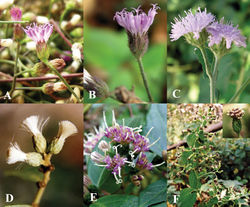Decaneuropsis cumingiana
| Notice: | This page is derived from the original publication listed below, whose author(s) should always be credited. Further contributors may edit and improve the content of this page and, consequently, need to be credited as well (see page history). Any assessment of factual correctness requires a careful review of the original article as well as of subsequent contributions.
If you are uncertain whether your planned contribution is correct or not, we suggest that you use the associated discussion page instead of editing the page directly. This page should be cited as follows (rationale):
Citation formats to copy and paste
BibTeX: @article{Bunwong2014PhytoKeys37, RIS/ Endnote: TY - JOUR Wikipedia/ Citizendium: <ref name="Bunwong2014PhytoKeys37">{{Citation See also the citation download page at the journal. |
Ordo: Asterales
Familia: Asteraceae
Genus: Decaneuropsis
Name
Decaneuropsis cumingiana (Benth.) H.Rob. & Skvarla, Proc. Biol. Soc. Washington 120(3): 364. 2007. – Wikispecies link – IPNI link – Pensoft Profile
- Vernonia cumingiana Benth. in Hook.f., Kew J. 4: 232. 1852.
- Decaneuropsis cumingiana Type. Philippines, M. Cuming 1092 (holotype: G!). Fig. 7D.
- Vernonia sangka Kerr, Bull. Misc. Inform. Kew 1935: 329. 1935.
- Decaneuropsis cumingiana Type: Thailand, Kanchanaburu, Sangka, A.F.G. Kerr 8302 (holotype: K!).
Description
Climbing or scandent shrubs, 3–10 m tall. Stems sprawling, young branches rounded, inconspicuously ribbed, ferruginous tomentose. Leaves 7–10 by 3–4 cm, elliptic to oblong-elliptic, margin entire, apex acute, base cuneate, subcoriaceous; upper surfaces puberulous with glands, lower surface sericeous with whip-shaped hairs, cylindrical hairs and capitate glands; lateral veins 5–6-paired; petioles up to 1 cm long. Capitulescences terminal and axillary, paniculate. Capitula campanulate, 12–15 mm long, pedunculate. Receptacle flat, 4–4.5 mm in diam., hairy. Involucres campanulate, in 5–6 series, 7–8 mm long, 6–7 mm in diam. Phyllaries imbricate, dull green, margin piliferous, outer surface ferruginous tomentose, glands capitate; the outer and the middle ones ovate, apex acute; the inner ones lanceolate to oblong, apex acute. Florets 20–30; corollas funnelform, purple, glandular, corolla tubes 5–6.5 mm long; corolla lobes ca. 2 mm long. Anthers 2.8–3 mm long, apical appendage acute, base obtuse. Styles purple, 7–7.5 mm long, branches 3.5–4 mm long. Achenes clavate, 3–3.5 mm long, 10-ribbed, puberulous without glands. Pappus in 2 series of bristles, the outer ones are shorter than the inner ones, the inner ones 9–9.5 mm long, persistent.
Distribution
Thailand: Chiang Mai, Nan, Lampang, Phetchabun, Kanchanaburi, Phra Nakhon Si Ayutthaya, Saraburi, Nakhon Nayok, Yala. Hong Kong, India, Laos, Myanmar, Vietnam, Philippines, New Guinea.
Specimens examined
Thailand, Phetchabun, Nam Nao national park, 16°44.29'N, 101°34.19'E, 18 Mar 2003, S. Bunwong 74 (KKU); Chiang Mai, Doi Sutep,15 Apr 1910, A.F.G. Kerr 1114 (BK, BM, K); Doi Sutep, 16 Feb 1958, Th. Sørensen, K. Larsen & B. Hansen 6942 (C, K); Lampang, 6 Mar 2525, Winit 1287 (BK, BKF, K), 31 Mar 1930, Winit 1916 (K); Saraburi, Mauk Lek, 9 Nov 1924, A. Marcan 1844 (BK, BM, K); Yala, Banang Sata, 10 Dec 1966, B. Sangkhachand 1409 (BKF).
Diagnostic characters
Decaneuropsis cumingiana is recognized by its ferruginous pubescence on the leaves and phyllaries.
Ecology
Evergreen or pine-oak forest, alt. 200–850 m; flowering November to April.
Vernacular name
Phaya Rak Pa (พญารักป่า), Pan Sieng (พันเซียง).
Taxon Treatment
- Bunwong, S; Chantaranothai, P; Keeley, S; 2014: Revisions and key to the Vernonieae (Compositae) of Thailand PhytoKeys, 37: 25-101. doi
Images
|
